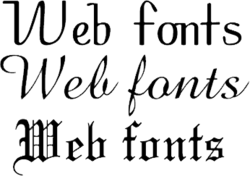
Web typography, like typography generally, is the design of pages – their layout and typeface choices. Unlike traditional print-based typography (where the page is fixed once typeset), pages intended for display on the World Wide Web have additional technical challenges and – given its ability to change the presentation dynamically – additional opportunities. Early web page designs were very simple due to technology limitations; modern designs use Cascading Style Sheets (CSS), JavaScript and other techniques to deliver the typographer's and the client's vision.
When HTML was first created, typefaces and styles were controlled exclusively by the settings of each web browser. There was no mechanism for individual Web pages to control font display until Netscape introduced the font element in 1995, which was then standardized in the HTML 3.2 specification. However, the computer font specified by the font element had to be installed on the user's computer or a fallback font, such as a browser's default sans-serif or monospace font, would be used. The first CSS specification was published in 1996 and provided the same capabilities.
The CSS2 specification was released in 1998 and attempted to improve the font selection process by adding font matching, synthesis and download. These techniques did not gain much use, and were removed in the CSS2.1 specification. However, Internet Explorer added support for the font downloading feature in version 4.0, released in 1997.[1] Font downloading was later included in the CSS3 fonts module, and has since been implemented in Safari 3.1, Opera 10 and Mozilla Firefox 3.5. This has subsequently increased interest in Web typography, as well as the use of font downloading.
- ^ Garaffa, Dave (2 September 1997). "Embedded Fonts In Microsoft IE4pr2". Internet.com. Archived from the original on 8 July 1998.